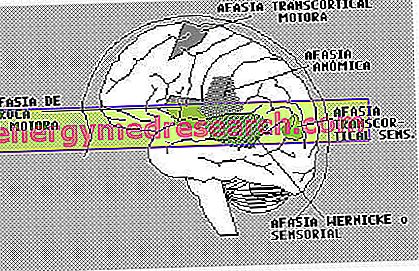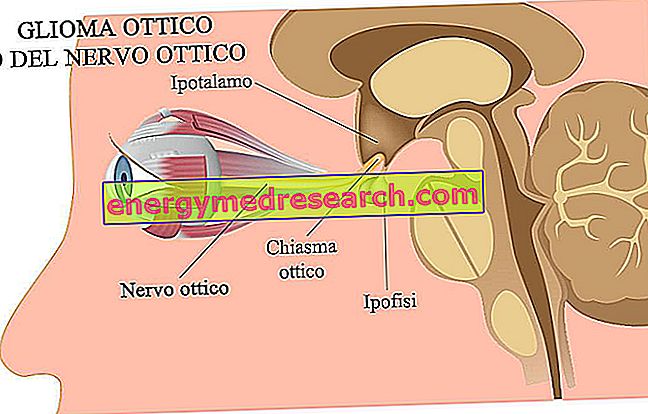Aphasia: definition
Aphasia is the title of the chapter concerning language disorders, basically related to the articulation and understanding of words: it is an acquired disorder, that is to say consequent to a trauma related to the cerebral hemisphere that coordinates the language. In the introductory article we have analyzed the general picture of aphasia: in this discussion the various forms of aphasia will be examined.
General classification
The aphasic forms are manifold and are distinguished on the basis of the quality / frequency of the speech, and of the resulting symptomatological characteristics.
- AFASIE FLUENTI
Sometimes, the flowing aphasias are so light that the affected patient does not understand his own language deficit: in fact, the intonation, rhythm, accent and duration of sentences are almost normal. What characterizes fluent aphasia is the not entirely productive speech: the subjects affected, in fact, are able to carry out only about twenty words per minute. Moreover, often their words are devoid of a complete meaning and lack a link that links one word to another. In such situations, we speak of an empty language .
In turn, fluent aphasias are classified into:
- Conduction or repetition aphasia: although the aphasic subject tries to repeat the words by imitation, he presents a serious difficulty in repeating words. However, understanding is not compromised.
- Abnormal aphasia (amnesia nominum or amnesic aphasia) : inability to intentionally name an object. The aphasic patient, in this case, preserves an almost fluent and spontaneous language, as well as oral and written comprehension, which remains unchanged. In other words, anomie appears suddenly, within a fluent and clear speech; probably, the cause refers to a lesion similar to that found in transcortical sensory aphasia, but of minor entity.
- Sensory or Wernike aphasia: the name derives from the brain area compromised by the lesion. Indeed, damage to the Wernike region generates possible disturbances in language production and understanding; the patient elaborates a particular linguistic code, artificial and rich in neologisms, sometimes incomprehensible. The patient is not aware of his disorder.
- Transcortical sensory aphasia : the repetition of words is only partially compromised. Patients tend to be almost talkative, speaking fluently, but lacking in meaning.
- AFASIE NON FLUENTI
As for non-fluent aphasias, most affected individuals are aware of their verbal deficiency: in this regard, patients - afflicted and defeated by the disease - tend to give up and refuse to talk.

Among the non fluent types of aphasia stand out:
- Dynamic aphasia : understanding abilities remain intact, despite the fact that speech skills are drastically reduced.
- Transcortical motor aphasia : affected patients struggle to spontaneously quibble; however, I am able to repeat the words and to name the objects - after indication or help - and to read aloud. The ability to understand written and oral language is also kept intact. A possible correlation between trans cortical motor aphasia and stuttering has been found.
- Transcortical mixed aphasia (language-area isolation syndrome): characterized both by a marked alteration of linguistic expression, and by a marked impairment of language comprehension. However, this form of aphasia does not hinder the ability to repeat or imitate words: the patient is unable to speak and express himself, but is fully aware of the disease.
- Broca aphasia (or motor aphasia): writing, reading and simple spontaneous language are seriously compromised and altered. The speech is telegraphic and the patient shows serious problems in the anagram of the words; the few sentences are often meaningless and lacking in articles, prepositions and adverbs. However, the understanding of words and concepts remains unchanged; consequently, patients suffering from Broca's aphasia maintain their intellectual abilities completely intact and are aware of their disorder. In this regard, often the affected subjects tend to despair, cry and get depressed.
Most often, the disease is caused by a serious injury to the pre-central areas of the brain.
- GLOBAL AFASIES
In global (or mixed) types of aphasia, speech is not at all fluent, so much so that it literally suppresses words. In this typology, the comprehension of the language is also heavily compromised. Global aphasia is defined as a serious alteration of language, since the production of speech, processing and understanding itself is affected. The left cerebral hemisphere is involved, an area in which both the perisilvonic cortex and the neighboring structures in the brain are located: for these reasons, the global form of aphasia is the most serious, usually due to a serious lesion of the cerebral artery media [taken from Netter's Internal Medicine, by Stephanie Engelhardt, Martin Kortenhaus]
- OTHER CLASSIFICATION OF AFASIA (based on the ability to understand / produce words)
Depending on the ability to understand language, aphasia can be further classified into:
- Receptorial aphasia : the patient's language is fluent and he is able to replace words with others. Auditory understanding is more problematic.
- Receptive aphasia : the aphasic subject has a better expressive capacity than the comprehensive one. In similar situations, the aphasic patient shows a significant inability to understand written and spoken language.
- Expressive or modifying aphasia : the difficulty in articulating words or sentences is very marked, often associated with the impossibility for the subject to gesticulate.
However, in general, aphasia is not completely receptive or completely expressive, since it is often characterized by both disorders [www.msd-italia.it]



